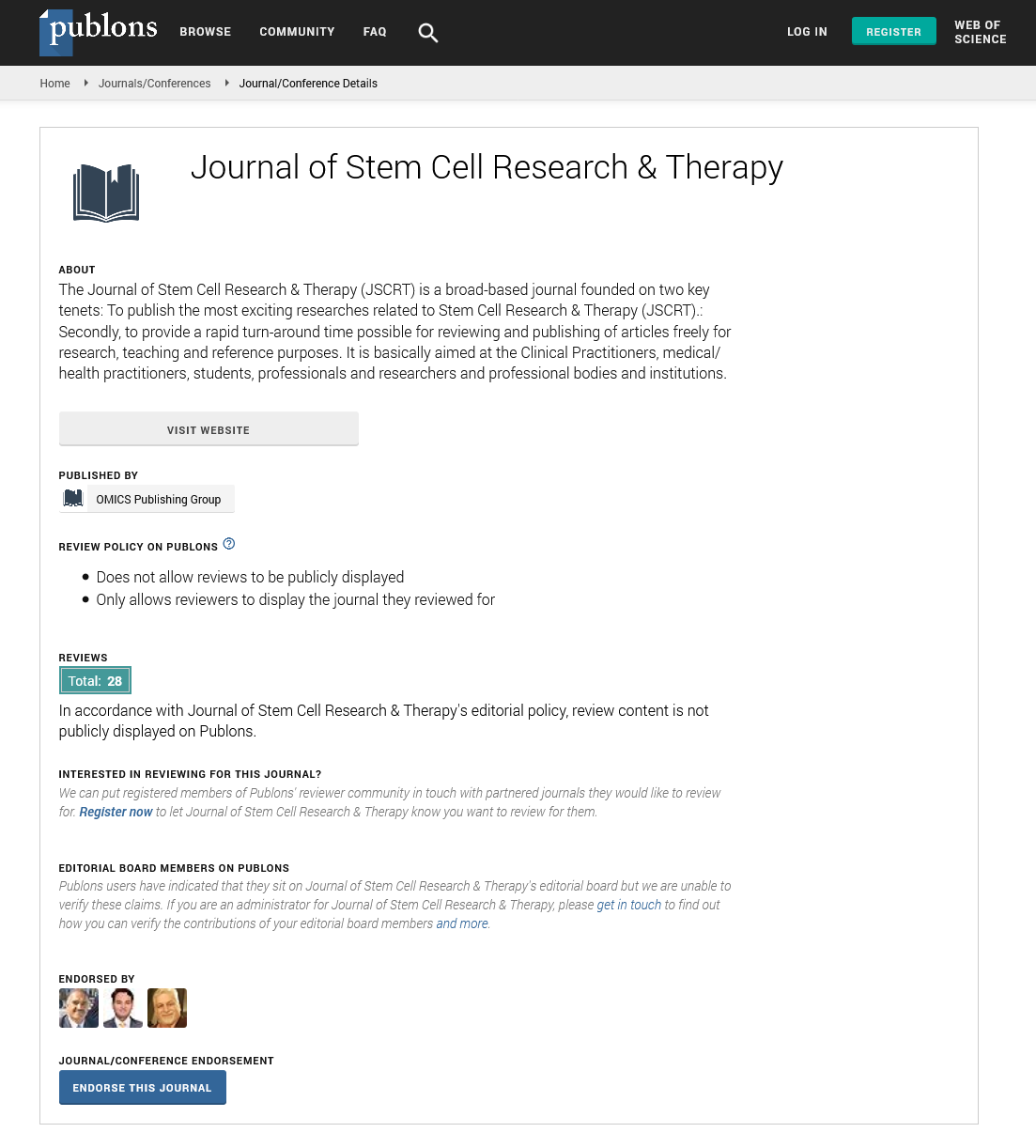Indexed In
- Open J Gate
- Genamics JournalSeek
- Academic Keys
- JournalTOCs
- China National Knowledge Infrastructure (CNKI)
- Ulrich's Periodicals Directory
- RefSeek
- Hamdard University
- EBSCO A-Z
- Directory of Abstract Indexing for Journals
- OCLC- WorldCat
- Publons
- Geneva Foundation for Medical Education and Research
- Euro Pub
- Google Scholar
Useful Links
Share This Page
Journal Flyer

Open Access Journals
- Agri and Aquaculture
- Biochemistry
- Bioinformatics & Systems Biology
- Business & Management
- Chemistry
- Clinical Sciences
- Engineering
- Food & Nutrition
- General Science
- Genetics & Molecular Biology
- Immunology & Microbiology
- Medical Sciences
- Neuroscience & Psychology
- Nursing & Health Care
- Pharmaceutical Sciences
Commentary - (2023) Volume 13, Issue 2
Current Therapeutic uses for Mesenchymal Stem Cells
Patrick Santos*Received: 03-Mar-2023, Manuscript No. JSCRT-23-20728; Editor assigned: 06-Mar-2023, Pre QC No. JSCRT-23-20728(PQ); Reviewed: 21-Mar-2023, QC No. JSCRT-23-20728; Revised: 28-Mar-2023, Manuscript No. JSCRT-23-20728(R); Published: 07-Apr-2023, DOI: 10.35248/2157-7633.23.13.588
Description
Mesenchymal stem cells (MSCs) are a type of multipotent stem cells that can differentiate into various cell types, including bone, cartilage, fat, and muscle cells. They are found in many tissues, including bone marrow, adipose tissue, umbilical cord, and placenta. MSCs have attracted considerable attention from researchers and clinicians due to their regenerative and immunomodulatory properties. In this article, we will explore the characteristics, functions, and therapeutic applications of MSCs. MSCs are a heterogeneous population of cells that share some common characteristics. They can be isolated from various tissues, and their phenotype and differentiation potential depend on the tissue of origin. However, all MSCs share some surface markers, including CD105, CD73, and CD90, and lack the expression of CD45, CD34, CD14 or CD11b, CD79a or CD19, and HLA-DR. MSCs have a spindle-shaped morphology and can undergo extensive proliferation without losing their differentiation potential.
Functions of MSCs
Regenerative potential: MSCs can differentiate into various cell types, including bone, cartilage, fat, and muscle cells, making them an attractive source of cells for regenerative medicine.
Immunomodulatory properties: MSCs can suppress the immune response by inhibiting the activation and proliferation of T cells, B cells, natural killer cells, and dendritic cells, and by inducing the generation of regulatory T cells.
Anti-inflammatory effects: MSCs can secrete anti-inflammatory cytokines, such as IL-10 and TGF-β, which can reduce inflammation and promote tissue repair.
Angiogenic effects: MSCs can secrete pro-angiogenic factors, such as Vascular Endothelial Growth Factor (VEGF), which can promote the formation of new blood vessels.
Therapeutic applications of MSCs
MSCs have shown great potential in various therapeutic applications, including:
Bone and cartilage repair: MSCs can differentiate into bone and cartilage cells and have been used in preclinical and clinical studies for the treatment of bone and cartilage defects.
Cardiovascular diseases: MSCs can promote angiogenesis and reduce inflammation, making them a potential therapy for cardiovascular diseases, such as myocardial infarction and peripheral arterial disease.
Autoimmune diseases: MSCs can suppress the immune response and have been used in preclinical and clinical studies for the treatment of autoimmune diseases, such as multiple sclerosis and systemic lupus erythematosus.
Acute Respiratory Distress Syndrome (ARDS): MSCs can reduce inflammation and promote tissue repair in the lungs, making them a potential therapy for ARDS.
Diabetes: MSCs can differentiate into insulin-producing cells and have been used in preclinical and clinical studies for the treatment of diabetes.
Despite the promising potential of MSCs in regenerative medicine and immunotherapy, several challenges need to be addressed before their widespread clinical use.
These challenges include
Standardization of isolation and characterization methods: There is a lack of standardization in the isolation and characterization of MSCs, which can lead to variations in their properties and efficacy.
Optimization of cell culture conditions: The optimal culture conditions for MSCs, including growth factors, cell density, and substrate, need to be optimized to maximize their proliferation and differentiation potential.
Understanding of the mechanisms of action: The mechanisms by which MSCs exert their therapeutic effects need to be better understood to optimize their clinical use.
Safety concerns: The safety of MSCs, including their potential for tumorigenicity and immunogenicity, needs to be thoroughly evaluated before their widespread.
Citation: Santos P (2023) Current Therapeutic uses for Mesenchymal Stem Cells. J Stem Cell Res Ther. 13:588.
Copyright: © 2023 Santos P. This is an open-access article distributed under the terms of the Creative Commons Attribution License, which permits unrestricted use, distribution, and reproduction in any medium, provided the original author and source are credited.

